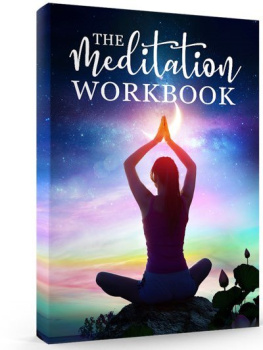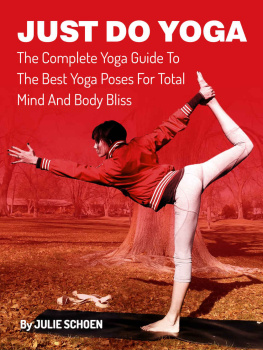Yoga
The Beginners Guide to Master Yoga, Lose Weight, Heal Your Body and Find the Inner Peace
By Kara Bridger
Table of Contents
I want to thank you and congratulate you for downloading the book, Yoga: The Beginners Guide to Master Yoga, Lose Weight, Heal Your Body and Find the Inner Peace.
This book contains proven steps and strategies on how to practice yoga. This book is the perfect guide for all beginners. It explains the history of yoga (which is very important if you intend to practice it). The book also introduces you to yogas types and principles.

Y ou have probably thought about practicing yoga (because it is so popular lately), but you always thought it would be too difficult. This book proves you wrong. No, yoga is not difficult. Yes, it is easy to learn.
Everything you need to know about yoga and the gear you need to purchase is right here in this book. The book shows and explains all yoga tools you should have, gives you advice to purchase the best yoga mat, and what kind of clothes you should wear while exercising.
Ultimately, this book is guide to lose weight. It will teach you how yoga (which doesnt burn as many calories as running) can make you lose weight. Not only lose, but it will prevent you from gaining weight later. You will read about all types of exercises you can do. All exercises are described in detail.
Additionally, this guide will name all health benefits of yoga (and there a lot of them). You will finally get to see why you should start exercising yoga right now. Its benefits are endless. Yoga unifies your mind, body, and soul. Thats what makes it different from all other practices and workouts. Yoga is the only discipline that can connect physical, mental, and spiritual spheres.
If you want to lose weight, improve health and fitness, and find your inner peace, then yoga is ideal practice for you. And this is why this book is the perfect solution for you. Here, youll be able to get all information about yoga for beginners without wasting your time on browsing online (and finding unreliable information along the way). Good luck. Namaste!
Thanks again for downloading this book, I hope you enjoy it!
Copyright 2018 by - All rights reserved.
T his document is geared towards providing exact and reliable information in regards to the topic and issue covered. The publication is sold with the idea that the publisher is not required to render accounting, officially permitted, or otherwise, qualified services. If advice is necessary, legal or professional, a practiced individual in the profession should be ordered.
From a Declaration of Principles which was accepted and approved equally by a Committee of the American Bar Association and a Committee of Publishers and Associations.
In no way is it legal to reproduce, duplicate, or transmit any part of this document in either electronic means or in printed format. Recording of this publication is strictly prohibited and any storage of this document is not allowed unless with written permission from the publisher. All rights reserved.
The information provided herein is stated to be truthful and consistent, in that any liability, in terms of inattention or otherwise, by any usage or abuse of any policies, processes, or directions contained within is the solitary and utter responsibility of the recipient reader. Under no circumstances will any legal responsibility or blame be held against the publisher for any reparation, damages, or monetary loss due to the information herein, either directly or indirectly.
Respective authors own all copyrights not held by the publisher. The information herein is offered for informational purposes solely, and is universal as so. The presentation of the information is without contract or any type of guarantee assurance.
The trademarks that are used are without any consent, and the publication of the trademark is without permission or backing by the trademark owner. All
trademarks and brands within this book are for clarifying purposes only and are the owned by the owners themselves, not affiliated with this document.
Chapter 1
Yoga Basics
Yoga is defined as discipline that a person tries to practice on mental, spiritual, and physical level. The yoga is practiced through series of postures. However, there is more to yoga. Its benefits are numerous and it has been present in the world since the ancient times.
Yoga is about unifying mind, and body. Practicing yoga isnt just a trend, or fashionable thing to do it is a way of improving your own life. This chapter will introduce yoga, its history, types and principles.
Meaning of yoga
Yoga has multiple meanings. However, the most widely used is Vedic Sanskrit and the meaning of yoga is defined as to join, to add, or to attach. Sanskrit contains numerous words that include yog in their root and their meanings are method, connection. Additionally, yoga can also mean combined.
Although the term and its derivation is still mainly unknown and its still a subject of numerous debates, one thing is certain yoga refers to unity of mind, body and soul.
History of yoga
Yoga has oral, not written tradition. This means that its principles were transmitted from teachers to students. Students would become teachers and teach their pupils about yoga. At some point, yogas sacred texts were written down, but it was done on the palm leaves which were fragile and were easy to destroy, lose, or damage.
However, even though there arent many written documents about yoga, and there is no ancient book that contains all yogas sacred texts, it can be roughly concluded when the practice started. Yogas origin is also the subject of many debates, some researches and historians claim it appeared 5000 years ago, while others think there is a possibility the yogas origin could be traced back to 10 000 years.
Therefore, for the better understanding of the discipline itself and its history, the yogas history development was divided in four periods, and they are:
Pre-classical yoga
Pre-classical yoga developed in Northern India by Indus-Sarasvati civilization about 5000 years ago. The word yoga was mentioned, for the first time, in the Rigveda [1] . Yoga was developed and preserved by Brahmans (mystic teachers and priests) and Rishis (poets who recited hymns). Brahmans and Rishis documented their beliefs and practices into the Upanishads [2] . Out of all Yogic scriptures, the most commonly known one is the Bhagavad-Gita. The scripture was composed around 500 B.C.
Next page

















